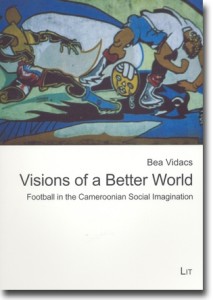
The 1990 World Cup hosted by Italy is often remembered for the exploits of Cameroon’s Indomitable Lions. Led by 38-year-old striker Roger Milla, Cameroon legitimized African football on the global stage with their 1-0 victory over Maradona’s Argentina in the opening game and then becoming the first African team to reach the World Cup quarterfinals. In 1994, Bea Vidacs, a Hungarian anthropologist based in the United States, landed in Yaoundé to begin her research on football and identity in Cameroon. Visions of a Better World: Football in the Cameroonian Social Imagination is a revised version of a doctoral thesis completed in 2002, a study that over the years midwifed several very good journal articles and chapters in scholarly collections.
Read my full review at H-Soz-u-Kult.
 In Making History, a BBC Radio 4 series exploring ordinary people’s links with the past, we learn about the first African team to play in Europe. Making History listener Eryl Freestone has a memoir written by her grandfather which describes a tour of black South African footballers that he helped organize in 1899, just as the South African War was about to start. Eryl meets with Chris Bolsmann at Aston University who has been researching the tour and was desperate to find an ancestor of WM Williams’ – Ery’s grandfather.
In Making History, a BBC Radio 4 series exploring ordinary people’s links with the past, we learn about the first African team to play in Europe. Making History listener Eryl Freestone has a memoir written by her grandfather which describes a tour of black South African footballers that he helped organize in 1899, just as the South African War was about to start. Eryl meets with Chris Bolsmann at Aston University who has been researching the tour and was desperate to find an ancestor of WM Williams’ – Ery’s grandfather.
Listen here (segment starts at 09:00).
Super-Mario and Friends Do Man U
Manchester United – Manchester City 1-6. Mario Balotelli and David Silva lead Roberto Mancini’s men to a historic victory at Old Trafford. Does this outrageously humiliating scoreline signal a changing of the guard in English football?
Fred’s Golazo
Fluminense’s Fred makes a diagonal run into the box, traps the high vertical cross with his chest, and executes a bicycle kick that sends the ball past the stunned Coritiba keeper and into the back of the net. Pure magic!
FIFA Bribes on Video: The Jack Warner Files

The Daily Telegraph web site posted video evidence of Jack Warner, former CONCACAF president and FIFA vice-president, explaining Mohammad Bin Hammam’s cash-for-votes scheme at a Caribbean Football Union meeting in March 2011. “If you are pious then go and build a church,” he tells the audience.
Short version of the video here, long version here
Bafana Buffoonery
South African players embarrass themselves and the nation by dancing in celebration after a 0-0 home draw with Sierra Leone on October 9, 2011 in Nelspruit. Niger had qualified instead! (For details see yesterday’s post here.)
South Africa’s Day of Shame
 On a day when the Springboks crashed out of the 2011 Rugby World Cup, Bafana Bafana failed to qualify for the 2012 African Nations Cup. After a squalid 0-0 draw against Sierra Leone, the South African players danced to the crowd at Mbombela Stadium in Nelspruit thinking they had done enough to qualify on goal difference.
On a day when the Springboks crashed out of the 2011 Rugby World Cup, Bafana Bafana failed to qualify for the 2012 African Nations Cup. After a squalid 0-0 draw against Sierra Leone, the South African players danced to the crowd at Mbombela Stadium in Nelspruit thinking they had done enough to qualify on goal difference.
But with Bafana, Niger, and Sierra Leone tied with nine points, as the rules of the competition clearly state, it was head-to-head points that settled the score. On that basis, Niger qualified. “I’m confused,” said Bafana coach Pitso Mosimane. Really?
Bafana’s inability to produce on the pitch is a natural reflection of the contradictions in the South African game. On the one hand there is a super-rich and gentrifying Premier Soccer League, but on the other hand there is rotting at multiple levels: adminstration; coaching and youth training; playing grounds in townships and villages; schools; and the female game. What the national team symbolizes in fact is the castle of cards that is South African football. The 2010 World Cup was a tremendous success, but local football continues to deteriorate. What’s needed is structural change and long-term sustainable development for the benefit of the 99 percent of SA football outside the PSL.